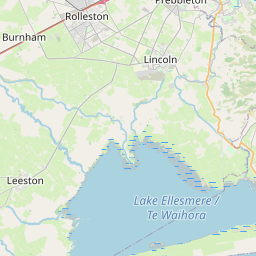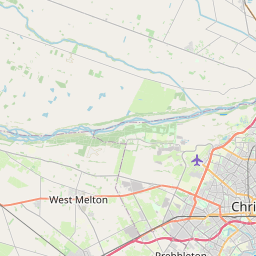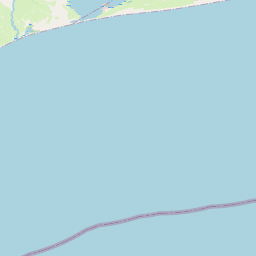Find out if and when you need to evacuate using our tsunami information and interactive map.
A tsunami evacuation zone is an area you may need to evacuate from if you feel a long or strong earthquake or if there is an official tsunami warning. The interactive map(external link) below lets you check to see what zone your property is in.
A tsunami evacuation zone is an area that you may need to evacuate from if you feel a long rolling earthquake that lasts more than a minute, or a strong earthquake that makes it hard to stand up, or if there is an official tsunami warning. You may be asked to stay out of the evacuation zone for many hours.
There are three tsunami evacuation zones for Christchurch city and Banks Peninsula.
Red evacuation zone: Long or strong, get gone
This is an area that is most likely to be affected by a tsunami. It includes the sea, estuaries, rivers, beaches and harbours. A tsunami of any size could cause strong currents and surges in the water.
You can expect to evacuate the red zone several times in your lifetime.
You should leave this zone immediately, if:
- You experience a long or strong earthquake
- You see sudden sea-level changes or hear unusual noises coming from the sea
- You receive an official warning from Civil Defence Emergency Management
Official warnings may be given through an Emergency Mobile Alert to your phone, on this website (ccc.govt.nz), radio, television, or social media. If there is an announcement to evacuate the zone you are in, follow the instructions immediately.
If you hear the tsunami warning sirens, check any of the above sources for further information.
Stay out of this zone until you are told by an official source that it’s safe to go back.
Orange evacuation zone: Long or strong, get gone
This is an area that is less likely to be affected by a tsunami. This includes areas on land that could be flooded in a large tsunami.
You can expect to evacuate the orange zone a few times in your lifetime.
You should leave this zone immediately, if:
- You experience a long or strong earthquake
- You see sudden sea-level changes or hear unusual noises coming from the sea
- You receive an official warning from Civil Defence Emergency Management
Official warnings may be given through an Emergency Mobile Alert to your phone, on this website (ccc.govt.nz), radio, television, or social media. If there is an announcement to evacuate the zone you are in, follow the instructions immediately.
If you hear the tsunami warning sirens, check any of the above sources for further information
Stay out of this zone until you are told by an official source that it’s safe to go back.
Yellow evacuation zone
You do not need to leave this zone if you feel a long or strong earthquake.
This is an area that is least likely to be affected by tsunami, but could be flooded or isolated in a very large tsunami.
It is possible this zone will be evacuated sometime in your lifetime, however it is unlikely.
You should leave this zone immediately if you receive an official warning from Civil Defence Emergency Management.
Official warnings may be given through an Emergency Mobile Alert to your phone, on this website (ccc.govt.nz), radio, television, or social media. If there is an announcement to evacuate the zone you are in, follow the instructions immediately.
If you hear the tsunami warning sirens, check any of the above sources for further information.
Stay out of this zone until you are told by an official source that it’s safe to go back.
Note: In most other parts of New Zealand, yellow zones need to be evacuated in a long or strong earthquake. You should check local tsunami evacuation zones when spending time on the coast.
No zone
This area is outside the tsunami evacuation zones. If you’re in this area:
- You don’t need to evacuate in a long or strong earthquake
- You don’t need to evacuate during an official tsunami warning from Civil Defence Emergency Management
- You may wish to open your home to family or friends who need to evacuate from a tsunami evacuation zone.
The tsunami evacuation zones were determined by hazard scientists and emergency managers and reflect our best knowledge as at November 2020.
As research about earthquakes and tsunami risk continue, and further modelling work develops, it is possible that the zones could change. This page will contain the latest information.
Where you'll go
Talk to your household about a safe place to go to outside of the tsunami evacuation zones. If you have friends or family that live outside of the evacuation zones, talk with them now about whether you can go to their place during an evacuation.
How you'll go
Once you know where you’re going, talk with your household about how you’ll get there. Plan what route you will take and what form of transport you will use. Think about routes from your home, workplace or any other place you could be within a tsunami evacuation zone.
Remember to secure your home as you normally would when leaving.
Travel actively
If you’re able to, walk or cycle to evacuate. Evacuating on foot or bike could make your evacuation faster.
Carpool
If you have to drive, plan to take extra passengers with you. Have a chat with your neighbours to see if they need a ride or help to evacuate. Carpooling reduces the number of cars on the road and helps everyone evacuate faster.
Public transport
Public transport, like buses, may not be operating during an evacuation. If you normally use public transport to get around, plan other options to evacuate.
Evacuating uphill
If you are near unstable slopes or cliffs, be alert for falling rocks and other debris that could be loosened by a strong earthquake. Earthquakes can also trigger landslides.
Livestock
If you have livestock in the tsunami evacuation zones, you may wish to move them to higher ground, or inland if you have time during an evacuation.
Schools and Early Childhood Centres
Schools and early childhood centres are required to have plans detailing their response to emergency events. Ask at your school or early childhood centre what arrangements they have in place and the steps you are expected to take to collect your child following an evacuation.
Rest Homes and Retirement Villages
If you have friends or family living in a rest home or retirement village within the tsunami evacuation zones, contact the rest home or retirement village to find out what their emergency plans are before an emergency. It's important that you don't go into tsunami evacuation zones when there is a tsunami warning.
How you'll stay informed
Information could change while you are evacuating, so make sure you have a way to stay up-to-date with official information, like a portable radio, or your mobile phone.
Official information will be available on:
- This website (ccc.govt.nz)
- RNZ National Radio – 101.7 FM or 675 AM
- The Hits – 97.7 FM or 96.5 FM
- Newstalk ZB – 100.1FM or 1098 AM
- More FM – 92.1 FM, 94.9FM or 99.1 FM
- Magic – 99.3 FM or 738 AM
- The Breeze – 94.5 FM
- Plains FM - 96.9FM
What you'll take
Grab bag
A tsunami warning may be in place for many hours so take some things with you. Pack anything you urgently need and can carry. Or keep these things in an accessible place so you can get them quickly when you’re evacuating. This could be personal items (e.g. medicine, glasses, and sanitary items), supplies for babies and pets, water bottle, snacks, and family documents (e.g. copy of driver licences).
Pets
Plan to take your pets, and anything they need (e.g. food, lead) with you. You may not be at home, so make a plan for your pets for when you’re not there. Talk to your neighbours or friends/family that live close, about whether they could take your pets when they evacuate.
Practice
The most important part of making a plan is talking about it with your household, and people you care about. Everyone should know what to do in case of a tsunami. The more you practice your evacuation plan and the routes you will take, the more comfortable everyone will feel.
Check out the Get Ready(external link) website for more information on how to make your plan.
In the event of a possible tsunami threat, warning signs and messages can come from several sources – natural and official.
Natural warnings
A natural warning may be the only warning for tsunami generated close to our shore. Natural warnings are:
- a rolling earthquake that lasts longer than a minute
- a strong earthquake that makes it hard to stand up
- unusual or sudden rise or fall in sea level
- unusual and loud noises coming from the sea – like a jet plane or a train
If you are in the red or orange evacuation zones you should evacuate immediately if you experience these warnings. Do not wait for an official warning.
Official warnings
Official warnings will normally be issued by Civil Defence Emergency Management and/or emergency services.
Official warnings will only be issued if there is enough time. The time it takes for a tsunami to reach our coastline depends on where it originates and how far it has to travel.
Official warnings may be given through an Emergency Mobile Alert to your phone, on ccc.govt.nz, radio, television, or social media. If there is an announcement to evacuate the zone you are in, follow the instructions immediately.
Emergency Mobile Alerts
Emergency Mobile Alerts are messages broadcasted by authorised agencies to keep people safe. The alerts can be targeted to areas affected by serious hazards, including tsunami. If your phone is on, capable, and inside the targeted location, you should get the alerts. You don’t have to download an app or subscribe to a service.
Visit the Get Ready website to find out more information.(external link)(external link)
Tsunami sirens
Tsunami sirens are installed along the Christchurch coastline. These could be activated for a distance source tsunami generated overseas (e.g across the Pacific Ocean) with more than three hours of warning time.
In some instances, if time permits, the sirens could also be sounded for a regional source tsunami generated in another area of New Zealand. This indicates a tsunami with one to three hours of warning time.
The sirens are not intended to warn you about a local source tsunami created close to our shore. A long or strong earthquake will be your only warning for this type of tsunami.
When the tsunami sirens sound for a tsunami warning, they will play a pre-recorded message to advise you what tsunami evacuation zones need to be evacuated.
|
Type of message |
Tsunami siren message |
Action required |
|
Evacuate Red and Orange |
[tone] [Attention. This is a tsunami warning. Evacuate the Red and Orange tsunami evacuation zones immediately.] |
Evacuate the Red and Orange tsunami evacuation zones immediately. Check official sources for further information once outside of the tsunami evacuation zones. |
|
Evacuate Red, Orange and Yellow |
[tone] [Attention. This is a tsunami warning. Evacuate the Red, Orange, Yellow tsunami evacuation zones immediately.] |
Evacuate the Red, Orange and Yellow tsunami evacuation zones immediately. Check official sources for further information once outside of the tsunami evacuation zones. |
|
Safe to return or All Clear |
[tone] [This is a civil defence all-clear message. Check official sources for more information.] |
The tsunami threat has now passed. Check official sources for information about when you can return home. |
|
Siren testing |
[tone] [This is a test of the tsunami warning sirens. Do not be alarmed. This is only a test.] |
No action is required. |
Primary tsunami evacuation routes are suggested routes to move out of tsunami evacuation zones.
- Harbour Road - Kainga Road - Marshlands Road (Kainga)
- Lower Styx Road - Marshlands Road (Styx)
- Beach Road - Mairehau Road (Northshore)
- Bowhill Road - Travis Road (North New Brighton)
- Hawke Street – Pages Road
- Towards city from Wainoni Road
- Bridge Street - Breezes Road (South New Brighton)
- Bridge Street - Dyers Road - Linwood Avenue (Southshore)
- Rocking Horse Road - Estuary Road - Bridge St (Southshore)
- Marine Parade - Bridge St (Southshore)
- Main Road - Ferry Road (Redcliffs)
- Wakefield Avenue - Evans Pass Road - Summit Road (Sumner)
- Ferry Road (Ferrymead)
- Bridle Path Road - Tunnel Road (Heathcote Valley)
Tsunami are created by underwater earthquakes, volcanic eruptions or landslides, and are made up of powerful waves or surges lasting for several hours or even days. Only the largest tsunami flood land; most tsunami are not big enough to flood land but can still cause strong and unpredictable currents and surges in the sea, which can be dangerous for people in the water, on beaches and at river mouths.
The first tsunami wave may not be the largest and waves can arrive for hours. So a tsunami warning can be in place for many hours.
The source of a tsunami can be local, regional or distant, depending on where it originates and how long it takes to travel to our coast.
| Type of tsunami | What you need to know |
| Local source tsunami |
The risk to Christchurch City However, a local source tsunami could create strong, unpredictable and dangerous currents and surges in the sea, estuaries, rivers, beaches and harbours. The risk to Banks Peninsula There are no known tsunami sources in the Canterbury Bight that would cause a local source tsunami along the Kaitorete/Birdlings Flat coast. Things to remember A local source tsunami will take less than one hour to reach the coast. It is unlikely there will be enough time to issue an official warning (including an Emergency Mobile Alert) for a local source tsunami. An earthquake that could cause a local source tsunami would be felt as a strong earthquake (making it hard to stand up). |
| Regional source tsunami |
The risk to Christchurch City This type of tsunami could flood low-lying areas of land along the Christchurch City coastline. In the worst-case scenario, significant areas of land could be flooded. The risk to Banks Peninsula This type of tsunami could flood land at the heads of Banks Peninsula harbours and bays. In the worst-case scenario, significant areas of land could be flooded. Things to remember There may be time to issue an official warning for a regional source tsunami (including an Emergency Mobile Alert), depending on how far away it is created, but the earthquake is still your best warning. An earthquake that could cause a regional source tsunami could be felt as rolling earthquake shaking of unusually long duration (longer than a minute). |
| Distant source tsunami |
The risk to Christchurch City This type of tsunami could flood low-lying areas of land along the Christchurch City coastline. In the worst-case scenario, significant areas of land could be flooded. The risk to Banks Peninsula This type of tsunami could flood land in the heads of Banks Peninsula harbours and bays. In the worst-case scenario, significant areas of land could be flooded. Things to remember An earthquake across the Pacific Ocean would not be felt in Christchurch or Banks Peninsula. There will be time for an official warning from Civil Defence Emergency Management. |
For more information on tsunamis visit the Environment Canterbury website.(external link)
Evacuation zones map
Use the magnifying glass to find your property and see if you live in an evacuation zone.



















Red evacuation zone
Orange evacuation zone
Yellow evacuation zone
Christchurch and Banks Peninsula boundary
Red evacuation zone
Orange evacuation zone
Yellow evacuation zone
Christchurch and Banks Peninsula boundary

